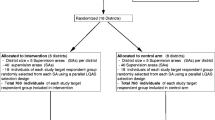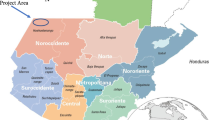Abstract
The processes for implementing effective programs at scale in low-income countries have not been well-documented in the peer-reviewed literature. This article describes the initial steps taken by one such program—the BRAC Manoshi Project, which now reaches a population of 6.9 million. The project has achieved notable increases in facility births and reductions in maternal and neonatal mortality. The focus of the paper is on the initial steps—community engagement, social mapping, and census taking. Community engagement began with (1) engaging local leaders, (2) creating Maternal, Neonatal, and Child Health Committees for populations of approximately 10,000 people, (3) responding to advice from the community, (4) social mapping of the community, and (5) census taking. Social mapping involved community members working with BRAC staff to map all important physical features that affect how the community carries out its daily functions—such as alleys, lanes and roads, schools, mosques, markets, pharmacies, health facilities, latrine sites, and ponds. As the social mapping progressed, it became possible to conduct household censuses with maps identifying every household and listing family members by household. Again, this was a process of collaboration between BRAC staff and community members. Thus, social mapping and census taking were also instrumental for advancing community engagement. These three processes—community engagement, social mapping, and census taking—can be valuable strategies for strengthening health programs in urban slum settings of low-income countries.

Similar content being viewed by others
Abbreviations
- BRAC:
-
Formerly Bangladesh Rural Advancement Committee
- CHWs:
-
Community health workers
- NGO:
-
Non-governmental organization
- SSs:
-
Shasthya Shebikas
- SKs:
-
Shasthya Kormis
- UBAs:
-
Urban birth attendants
References
UN. World Urbanization Prospects: the 2014 Revision, (ST/ESA/SER.A/366). 2015. Available at http://esa.un.org/unpd/wup/FinalReport/WUP2014-Report.pdf. Accessed Dec 20 2015.
United Nations. The Millennium Development Goals Report 2014. 2014. Available at http://www.un.org/millenniumgoals/2014%20MDG%20report/MDG%202014%20English%20web.pdf. Accessed Dec 20 2015.
UN-Habitat. The Challenge of Slums: Global Report on Human Settlements 2003. 2003. http://www.unhabitat.org.jo/pdf/GRHS.2003.pdf. Accessed Dec 20 2015.
UN. Population Distribution, Urbanization, Internal Migration and Development: an International Perspective. 2011. Available at http://www.un.org/esa/population/publications/PopDistribUrbanization/PopulationDistributionUrbanization.pdf. Accessed Dec 20 2015.
UN. End Poverty: Millennium Development Goals and Beyond 2015. Goal 7. Environmental Sustainability 2014. Available at http://www.un.org/millenniumgoals/environ.shtml. Accessed Dec 20 2015.
Prakash R, Kumar A. Urban poverty and utilization of maternal and child health care services in India. J Biosoc Sci. 2013; 45(4): 433–49.
Yuan B, Qian X, Thomsen S. Disadvantaged populations in maternal health in China who and why? Global Health Action. 2013; 6: 19542.
Vasquez F, Paraje G, Estay M. Income-related inequality in health and health care utilization in Chile, 2000–2009. Rev Panam Salud Publica. 2013; 33(2): 98–106.
Zhao Q, Huang ZJ, Yang S, Pan J, Smith B, Xu B. The utilization of antenatal care among rural-to-urban migrant women in Shanghai: a hospital-based cross-sectional study. BMC Public Health. 2012; 12: 1012.
Zyaambo C, Siziya S, Fylkesnes K. Health status and socio-economic factors associated with health facility utilization in rural and urban areas in Zambia. BMC Health Serv Res. 2012; 12: 389.
Emina J, Beguy D, Zulu EM, et al. Monitoring of health and demographic outcomes in poor urban settlements: evidence from the Nairobi Urban Health and Demographic Surveillance System. J Urban Health: Bull New York Acad Med. 2011; 88(Suppl 2): S200–18.
Islam MM, Azad KM. Rural–urban migration and child survival in urban Bangladesh: are the urban migrants and poor disadvantaged? J Biosoc Sci. 2008; 40(1): 83–96.
Hazarika I. Women’s reproductive health in slum populations in India: evidence from NFHS-3. J Urban Health: Bull New York Acad Med. 2010; 87(2): 264–77.
Moran AC, Choudhury N, Uz Zaman Khan N, et al. Newborn care practices among slum dwellers in Dhaka, Bangladesh: a quantitative and qualitative exploratory study. BMC Pregnancy Childbirth. 2009; 9: 54.
Khatun F, Rasheed S, Moran AC, et al. Causes of neonatal and maternal deaths in Dhaka slums: implications for service delivery. BMC Public Health. 2012; 12: 84.
More NS, Bapat U, Das S, et al. Community mobilization in Mumbai slums to improve perinatal care and outcomes: a cluster randomized controlled trial. PLoS Med. 2012; 9(7), e1001257.
Zulu EM, Beguy D, Ezeh AC, et al. Overview of migration, poverty and health dynamics in Nairobi City’s slum settlements. J Urban Health: Bull New York Acad Med. 2011; 88(Suppl 2): S185–99.
BRAC. BRAC Annual Report, 2014. 2014. Available at http://www.brac.net/sites/default/files/ar2014/BRAC-annual-report-14.pdf. Accessed Dec 20 2015.
Manoshi Project. Manoshi Internal Data Report, 2012. Dhaka, Bangladesh: BRAC; 2013.
Manoshi Project. Manoshi Internal Data Report, 2013. Dhaka, Bangladesh: BRAC; 2014.
National Institute of Population Research and Training (NIPORT), Mitra and Associates, and ICF International. Bangladesh Demographic and Health Survey 2014: Key Indicators. Dhaka, Bangladesh, and Rockville, Maryland, USA: NIPORT, Mitra and Associates, and ICF International; 2015.
Streatfield P, Arifeen S. Bangladesh Maternal Mortality and Health Survey 2010. Dhaka, Bangladesh: icddr,b; 2010.
Quayyum Z, Khan MN, Quayyum T, Nasreen HE, Chowdhury M, Ensor T. “Can community level interventions have an impact on equity and utilization of maternal health care”—evidence from rural Bangladesh. Int J Equity Health. 2013; 12: 22.
Darmstadt GL, Lee AC, Cousens S, et al. 60 Million non-facility births: who can deliver in community settings to reduce intrapartum-related deaths? Int J Gynaecol Obstet. 2009; 107(Suppl 1): S89–112.
Littrell M, Moukam LV, Libite R, Youmba JC, Baugh G. Narrowing the treatment gap with equitable access: mid-term outcomes of a community case management program in Cameroon. Health Policy Plan. 2013; 28(7): 705–16.
le Roux IM, Tomlinson M, Harwood JM, et al. Outcomes of home visits for pregnant mothers and their infants: a cluster randomized controlled trial. AIDS. 2013; 27(9): 1461–71.
Nsona H, Mtimuni A, Daelmans B, et al. Scaling up integrated community case management of childhood illness: update from Malawi. Am J Trop Med Hyg. 2012; 87(5 Suppl): 54–60.
Kisia J, Nelima F, Otieno DO, et al. Factors associated with utilization of community health workers in improving access to malaria treatment among children in Kenya. Malar J. 2012; 11: 248.
Smith JM, Gubin R, Holston MM, Fullerton J, Prata N. Misoprostol for postpartum hemorrhage prevention at home birth: an integrative review of global implementation experience to date. BMC Pregnancy Childbirth. 2013; 13: 44.
Farmer PE, Nutt CT, Wagner CM, et al. Reduced premature mortality in Rwanda: lessons from success. BMJ. 2013; 346: f65.
Mugeni C, Levine AC, Munyaneza RM, et al. Nationwide implementation of integrated community case management of childhood illness in Rwanda. Global Health, Sci Pract. 2014; 2(3): 328–41.
Bang AT, Bang RA. Background of the field trial of home-based neonatal care in Gadchiroli, India. J Perinatol. 2005; 25(Suppl 1): S3–10.
Mridha MK, Hossain A, Alam B, et al. The Perceptions of Community Groups to Improve MNCH in Urban Slums: an Exploratory Case Study of Korail Slum in Dhaka. Dhaka, Bangladesh: icddr,b and BRAC; 2009.
Ahmed SM, Hossain A, Khan MA, et al. Using formative research to develop MNCH programme in urban slums in Bangladesh: experiences from MANOSHI, BRAC. BMC Public Health. 2010; 10: 663.
Khan M, Ahmed S. The “Birthing Hut” Facilities of Manoshi: a two-part paper exploring the inception and post-inception phases of urban delivery centers. Dhaka, Bangladesh: icddr,b and BRAC; 2009.
Banu M, Nahar S, Nasreen H. Assessing the MANOSHI Referral System: addressing delays in seeking emergency obstetric care in Dhaka’s slums. Dhaka, Bangladesh: icddr,b and BRAC; 2010.
Story WT, Burgard SA, Lori JR, Taleb F, Ali NA, Hoque DM. Husbands’ involvement in delivery care utilization in rural Bangladesh: a qualitative study. BMC Pregnancy Childbirth. 2012; 12: 28.
Aronson RE, Wallis AB, O’Campo PJ, Schafer P. Neighborhood mapping and evaluation: a methodology for participatory community health initiatives. Matern Child Health J. 2007; 11(4): 373–83.
Roy T, Marcil L, Chowdhury R, Afsana K, Perry H. The BRAC Manoshi Approach to Initiating a Maternal, Neonatal and Child Health Project in Urban Slums with Social Mapping, Census Taking, and Community Engagement2014. Available at http://www.brac.net/sites/default/files/portals/Manoshi-book-v3-1.pdf. Accessed Dec 20 2015.
Acknowledgments
We thank the people of slum communities in Bangladesh and the staff of the BRAC Manoshi Project for their assistance in gathering the information used for this article. We also thank the Lipitz Public Health Policy Fund for its support of Dr. Marcil’s participation in this study. The Bill & Melinda Gates Foundation provided funding from 2007 to 2011 for the BRAC Manoshi Project.
Author information
Authors and Affiliations
Corresponding author
Rights and permissions
About this article
Cite this article
Marcil, L., Afsana, K. & Perry, H.B. First Steps in Initiating an Effective Maternal, Neonatal, and Child Health Program in Urban Slums: the BRAC Manoshi Project’s Experience with Community Engagement, Social Mapping, and Census Taking in Bangladesh. J Urban Health 93, 6–18 (2016). https://doi.org/10.1007/s11524-016-0026-0
Published:
Issue Date:
DOI: https://doi.org/10.1007/s11524-016-0026-0




